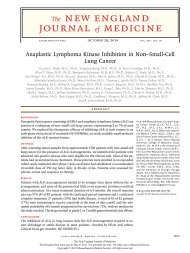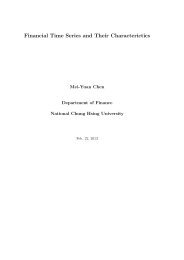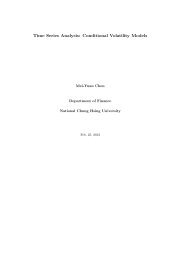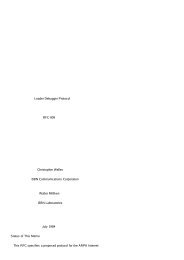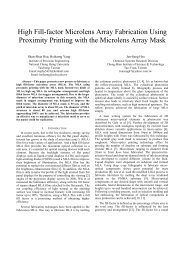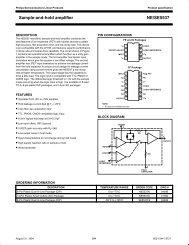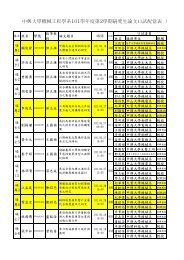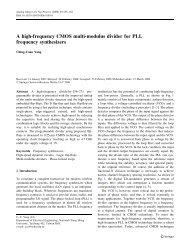A Low-Voltage High-Frequency CMOS LC-VCO Using a ...
A Low-Voltage High-Frequency CMOS LC-VCO Using a ...
A Low-Voltage High-Frequency CMOS LC-VCO Using a ...
You also want an ePaper? Increase the reach of your titles
YUMPU automatically turns print PDFs into web optimized ePapers that Google loves.
Fig. 3 <strong>LC</strong> oscillation circuit equivalent<br />
Fig. 2 The proposed <strong>LC</strong>-<strong>VCO</strong> with transformer based inductors<br />
constant part in the tank must be minimized. However, it<br />
nevertheless suffers from a trade-off between the<br />
dynamic range and the operating frequency. The parasitic<br />
capacitances from the transistors and varactor constitute<br />
a significant fraction of the overall capacitance, thereby<br />
limiting tuning range [1].<br />
B. Proposed <strong>LC</strong>-<strong>VCO</strong> <strong>Using</strong> a Transformer Based<br />
Inductor<br />
To exclude the effective parasitic capacitor, an<br />
<strong>LC</strong>-based oscillator scheme with a symmetry<br />
transformer-based inductor is shown in Fig. 2. The<br />
symmetry transformer is placed between the gate and<br />
drain of M 1<br />
, the circuit with a feedback loop to oscillate.<br />
In order to reduce the required supply voltage and to<br />
eliminate additional noise contribution, the tail current in<br />
a conventional cross-coupled <strong>VCO</strong> is replaced by a<br />
system inductor L 5<br />
-L 6<br />
. The <strong>LC</strong> oscillation scheme formed<br />
by inductor, the varactor and the transistors but without<br />
effective parasitic capacitor (C p<br />
). The total capacitance<br />
seen from X to ground is equal to C toto<br />
plus the Miller<br />
multiplication of CGS + CDB + 2CGD + C + C , assumed<br />
0 V<br />
A<br />
V<br />
=− 1. Now the varactor capacitance can be calculated.<br />
All contributions to C toto<br />
are identified as:<br />
If follows that<br />
C = C + C + 2C + C + C (4)<br />
toto GS DB GD 0 V<br />
1<br />
C = − C + C + C + C<br />
ω × L<br />
[ 2<br />
0 ]<br />
V DB GD GS<br />
osc<br />
(5)<br />
As expected, total capacitance (C toto<br />
) in (2) is reduced<br />
to (4) for proposed <strong>LC</strong>-<strong>VCO</strong>. The resonant circuit is<br />
generally the type of parallel <strong>LC</strong>-tank, which is formed<br />
by the equivalent inductance from the primary coil of the<br />
transformer and the parasitic capacitances across the<br />
Fig. 4 Half circuit equivalent<br />
port.<br />
III.<br />
SIMPLIFIED LINEAR ANALYSIS<br />
We exploit the <strong>LC</strong> oscillation scheme of Fig. 3 to<br />
construct the equivalent circuit shown in Fig. 2. It is<br />
composed of three mutual inductors L 1<br />
-L 6<br />
[5], a MOS<br />
transistor pair. The inductors possess the coupling factor<br />
K and coupling polarity is assigned by the dot convention<br />
in the figure. The <strong>LC</strong> oscillation operation can be<br />
explained by considering the half-circuit model of Fig. 4.<br />
In the figure, R 1<br />
and L 1<br />
represent the series resistance and<br />
inductance of the primary coil respectively while R 2<br />
and<br />
L 2<br />
represents that of the secondary coil; C is the effective<br />
tank capacitance. In this work, a symmetric structure of<br />
the transformer is adopted, thereby L 1<br />
= L 2<br />
= L, and R 1<br />
=<br />
R 2<br />
= R. By considering the resonator core’s loop in Fig. 4,<br />
we have<br />
1<br />
+ × − × + × = 0 (6)<br />
sC<br />
( sL R) i2 i1 sKL i2<br />
i = g × v<br />
(7)<br />
1 m1<br />
vx<br />
sg<br />
1<br />
=− i2<br />
× (8)<br />
sC<br />
546



